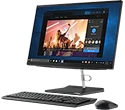What is a smart home hub?
A smart home hub is a control device or application through which homeowners can monitor and adjust the automated features of a residence. They come as hardware, such as a keypad, or as software, such as a mobile app, or both. Smart home hubs have existed for decades, but they really took off with the advent of fast home wireless technology and the explosion of new smart home devices that followed.
Whatever their form, hubs aim to help people manage the various connected parts of a smart home -- from adjusting the thermostat settings to unlocking a door for the babysitter to sending the family's latest grocery list to the store for delivery. The latest trend in hubs are today's increasingly popular smart speakers and smart displays, such as the Lenovo Smart Assistant and Lenovo Smart Display, which can integrate with many smart home devices to create a kind of ad-hoc hub.
Evolution of the smart home hub
The first smart home hubs were typically wall-mounted units and served as integral parts of hardwired, brand-specific, whole-home automation systems. Later, hubs evolved into network nerve centers responsible for controlling various systems and devices remotely, first over narrow-band radio signals and later through general home wireless connections.
The move to wireless precipitated the rapid growth in smart home technologies seen in recent years, including new after-market hubs that control products from multiple manufacturers. It also spawned today's growing market of individual smart home devices (versus whole-home systems), such as smart plugs, smart bulbs, and smart cameras.
Can I use a smart speaker or smart display as a smart home hub?
Now, the trend is to manage a wide array of do-it-yourself smart home devices using one of the new smart speakers or smart displays as the hub. The same virtual assistants that power these products, such as Amazon Alexa and Google Assistant, can also be configured to control popular smart home gadgets, ranging from video doorbells to security cameras to audio/video systems and more. Both the Lenovo Smart Assistant and the Lenovo Smart Display can pair to hundreds of smart devices.
Not every smart home component is immediately connectable to a smart speaker or smart display, and in some cases, you'll still need the original hub device or software to control certain functions. (In other words, the speakers and displays sometimes can communicate directly with the hub device or app but not with the components the hub controls.) However, an increasing number of smart home gadgets are pre-configured to work through smart speakers and smart displays, making installation and integration easier than ever. Plus, manufacturers are regularly releasing new "skills" (for Amazon Alexa), "routines" (for Google Assistant), and "scenes" (for Apple HomePod) that promise to help you manage multiple separate devices as though they are an integrated smart home system.





















